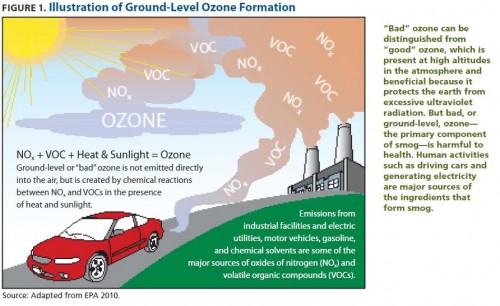Ozone is the name scientists give to the molecule that is formed when three oxygen atoms get together. You have probably heard of the stuff because there is a “hole” in the ozone layer. High altitude ozone does a very good job of stopping radiation from the sun that would give most of us a nasty case of skin cancer, the hole in this layer is of great concern. Which is why certain types of chemicals have been phased out, to allow this hole to fill back in with ozone.
So ozone is good right? It protects us from cancer causing radiation. Yes and no, ozone high in the sky is a vital part of the natural world that keeps us safe, however ozone itself is pretty toxic stuff and at ground level is not nearly as nice.
Unchecked global warming could threaten public health and increase health costs by exacerbating ground-level ozone, according to a peer-reviewed report released today by the Union of Concerned Scientists (UCS).
The report, “Climate Change and Your Health: Rising Temperatures, Worsening Ozone Pollution,” found climate change-induced ozone increases could result in 2.8 million additional serious respiratory illnesses, 5,100 additional infants and seniors hospitalized with serious breathing problems, and 944,000 additional missed school days in the United States in 2020.
All told, these and other health-related impacts could cost approximately $5.4 billion. And if global warming pollution continues unabated, these impacts and costs could be significantly higher.
“Even a small increase in ozone due to a warmer climate would have a significant impact on public health,” said UCS public health expert Liz Perera, a report co-author. “It would mean more asthma attacks, respiratory illnesses, emergency room trips, and premature deaths.”
Ground-level ozone, the primary component of smog, is generated by chemical reactions between nitrogen oxides and volatile organic compounds (VOCs) triggered by heat and sunlight. Warmer average temperatures from a changing climate may elevate ozone concentrations in many parts of the country, especially in and around urban areas.
Warmer temperatures also are associated with stagnant air conditions that can cause ozone pollution to settle over an area and remain for extended periods of time.
The UCS analysis, which used the Environmental Protection Agency’s (EPA) Environmental Benefits Mapping model, calculated national impacts and ranked the 10 states most likely to experience the worst health impacts and highest costs in 2020.
In terms of costs, it found that California would be hit hardest, followed by Texas, New York, Pennsylvania, Illinois, Ohio, Michigan, North Carolina, New Jersey and Virginia. These states are most vulnerable because they have a combination of the largest number of residents living in urban areas, large numbers of children and seniors, and high levels of nitrogen oxides and VOC emissions from vehicles and power plants.
Overall, the report estimated increased climate change-induced ozone levels in 40 states and the District of Columbia. Studies on climate change and ozone in the Southeast and Northwest are either inconclusive or show no effect, so UCS excluded states in those regions from its analysis. Hawaii and Alaska also were excluded due to model limitations.
Clean Air Act standards have reduced ozone-forming pollutants nationally, but many counties and states are still are unable to meet the federal ozone standard. In the coming months, the EPA is expected to strengthen this standard, which, in a warming world, will be even more important to safeguard public health and improve air quality.
Average U.S. temperatures have increased more than 2º Fahrenheit (F) during the past century. If global warming emissions continue to increase, average U.S. temperatures could rise 3º to 5.5º F by 2050. These temperature increases could result in approximately 11.8 million additional serious respiratory illnesses, 29,600 more infant and senior hospitalizations, and 4.1 million additional lost school days in 2050, according to UCS’s analysis.
Conversely, if global warming emissions decline and average U.S. temperatures increase only 2º to 4º F by 2050, the health impacts associated with climate change-induced ozone could be reduced by approximately 70 percent compared with the higher emissions scenario. Of course, nitrogen oxides and VOC emissions will continue to play a dominant role in ozone formation and must be reduced significantly to mitigate ozone pollution’s threat to public health.
“The good news is we can address both ozone pollution and climate change by cutting fossil fuel emissions,” said Todd Sanford, a UCS climate scientist and report co-author. “Doing that would protect public health, the environment, and the economy.”
